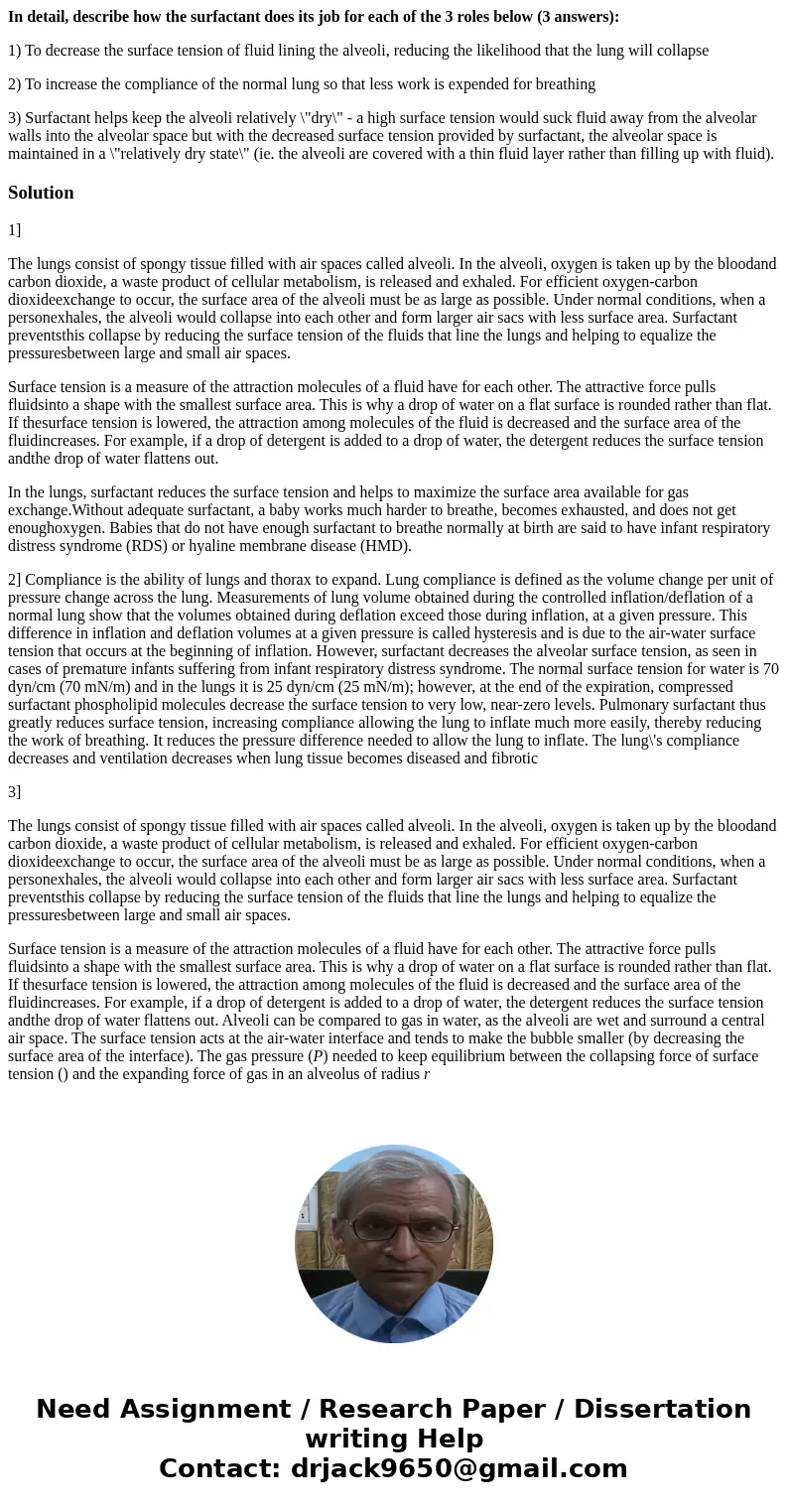In detail describe how the surfactant does its job for each
In detail, describe how the surfactant does its job for each of the 3 roles below (3 answers):
1) To decrease the surface tension of fluid lining the alveoli, reducing the likelihood that the lung will collapse
2) To increase the compliance of the normal lung so that less work is expended for breathing
3) Surfactant helps keep the alveoli relatively \"dry\" - a high surface tension would suck fluid away from the alveolar walls into the alveolar space but with the decreased surface tension provided by surfactant, the alveolar space is maintained in a \"relatively dry state\" (ie. the alveoli are covered with a thin fluid layer rather than filling up with fluid).
Solution
1]
The lungs consist of spongy tissue filled with air spaces called alveoli. In the alveoli, oxygen is taken up by the bloodand carbon dioxide, a waste product of cellular metabolism, is released and exhaled. For efficient oxygen-carbon dioxideexchange to occur, the surface area of the alveoli must be as large as possible. Under normal conditions, when a personexhales, the alveoli would collapse into each other and form larger air sacs with less surface area. Surfactant preventsthis collapse by reducing the surface tension of the fluids that line the lungs and helping to equalize the pressuresbetween large and small air spaces.
Surface tension is a measure of the attraction molecules of a fluid have for each other. The attractive force pulls fluidsinto a shape with the smallest surface area. This is why a drop of water on a flat surface is rounded rather than flat. If thesurface tension is lowered, the attraction among molecules of the fluid is decreased and the surface area of the fluidincreases. For example, if a drop of detergent is added to a drop of water, the detergent reduces the surface tension andthe drop of water flattens out.
In the lungs, surfactant reduces the surface tension and helps to maximize the surface area available for gas exchange.Without adequate surfactant, a baby works much harder to breathe, becomes exhausted, and does not get enoughoxygen. Babies that do not have enough surfactant to breathe normally at birth are said to have infant respiratory distress syndrome (RDS) or hyaline membrane disease (HMD).
2] Compliance is the ability of lungs and thorax to expand. Lung compliance is defined as the volume change per unit of pressure change across the lung. Measurements of lung volume obtained during the controlled inflation/deflation of a normal lung show that the volumes obtained during deflation exceed those during inflation, at a given pressure. This difference in inflation and deflation volumes at a given pressure is called hysteresis and is due to the air-water surface tension that occurs at the beginning of inflation. However, surfactant decreases the alveolar surface tension, as seen in cases of premature infants suffering from infant respiratory distress syndrome. The normal surface tension for water is 70 dyn/cm (70 mN/m) and in the lungs it is 25 dyn/cm (25 mN/m); however, at the end of the expiration, compressed surfactant phospholipid molecules decrease the surface tension to very low, near-zero levels. Pulmonary surfactant thus greatly reduces surface tension, increasing compliance allowing the lung to inflate much more easily, thereby reducing the work of breathing. It reduces the pressure difference needed to allow the lung to inflate. The lung\'s compliance decreases and ventilation decreases when lung tissue becomes diseased and fibrotic
3]
The lungs consist of spongy tissue filled with air spaces called alveoli. In the alveoli, oxygen is taken up by the bloodand carbon dioxide, a waste product of cellular metabolism, is released and exhaled. For efficient oxygen-carbon dioxideexchange to occur, the surface area of the alveoli must be as large as possible. Under normal conditions, when a personexhales, the alveoli would collapse into each other and form larger air sacs with less surface area. Surfactant preventsthis collapse by reducing the surface tension of the fluids that line the lungs and helping to equalize the pressuresbetween large and small air spaces.
Surface tension is a measure of the attraction molecules of a fluid have for each other. The attractive force pulls fluidsinto a shape with the smallest surface area. This is why a drop of water on a flat surface is rounded rather than flat. If thesurface tension is lowered, the attraction among molecules of the fluid is decreased and the surface area of the fluidincreases. For example, if a drop of detergent is added to a drop of water, the detergent reduces the surface tension andthe drop of water flattens out. Alveoli can be compared to gas in water, as the alveoli are wet and surround a central air space. The surface tension acts at the air-water interface and tends to make the bubble smaller (by decreasing the surface area of the interface). The gas pressure (P) needed to keep equilibrium between the collapsing force of surface tension () and the expanding force of gas in an alveolus of radius r

 Homework Sourse
Homework Sourse